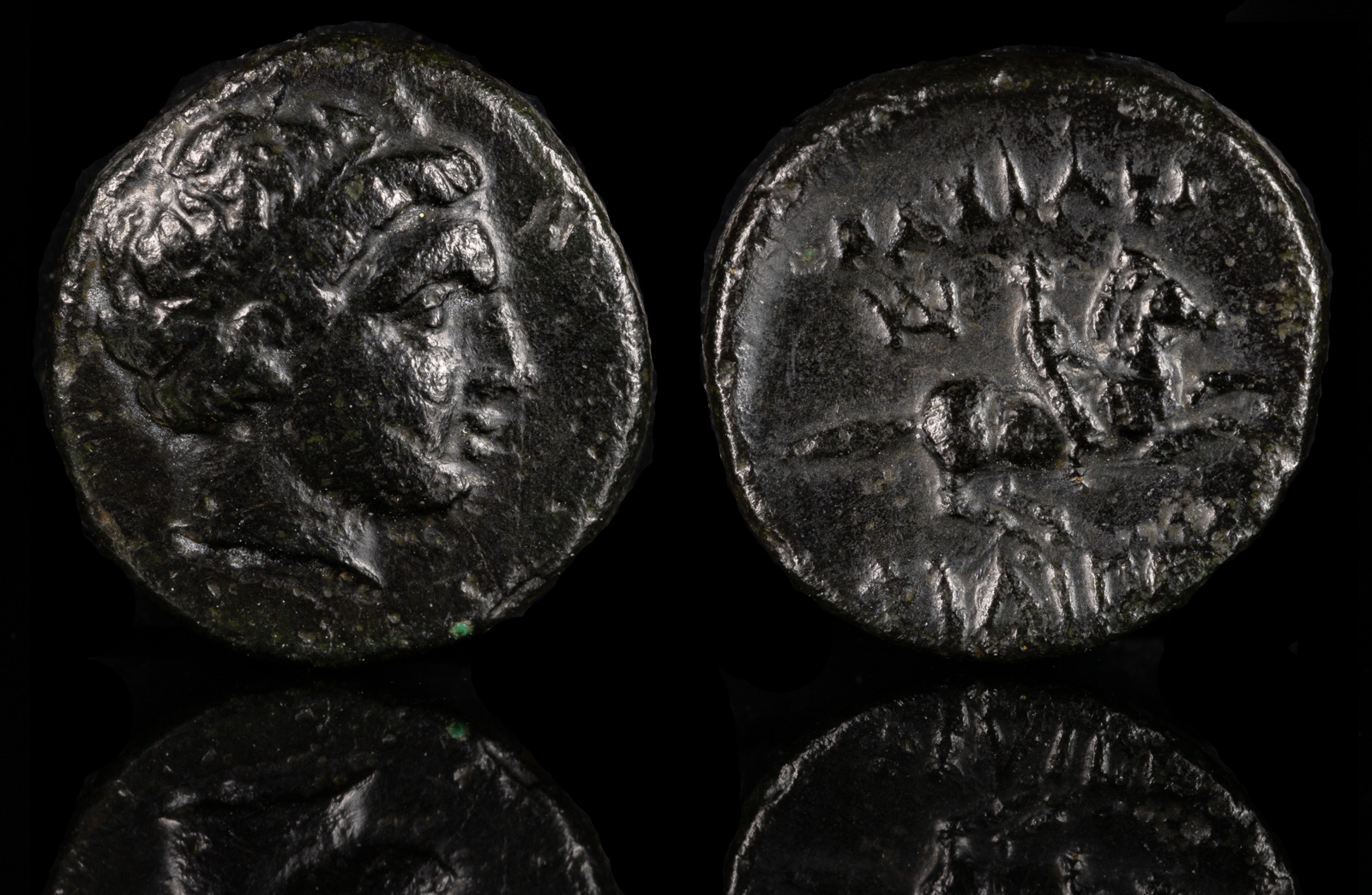
Philip III Arrhidaios
AE 12mm 1.27g
Head of Apollo right, hair bound with tainia
rev. Horseman galloping right, monogram in left field,
BAΣIΛEΩΣ above, ΦIΛIΠΠOY below
Müller P65 | SNG.Copenhagen 64 | Price P64 Thompson page 59, 217 | Sear-
Ex Henzen
This is an extremely rare coin of Philip IV of Macedon, who ruled for only four months after his father Kassander died of wasting disease, before he passed from the same ailment. The only slight problems with this attribution are that chances are this coin was not minted under Philip’s authority, nor did he have any control over where it was minted, nor was he even born at the time. Understanding, therefore, how this coin can be attributed to him requires a story that involves two emperors who never ruled, a great deal of confusion, and the mafia.
Philip IV ruled in 297 BCE, but to begin to understand this coin we need to revisit the period right after Alexander the Great‘s death in 323 BCE. At the time, there was a great debate on who would rule Alexander’s vast empire. The two leading candidates were his son, Alexander IV, and his brother Philip III. Challenges faced both. Young Alexander IV wasn’t actually born yet, but Alexander the Great‘s wife Roxana was sure it was a boy and, lucky for her, she was right. Philip III, on the other hand, was mentally incapacitated. Still, these were the best two bad choices out there.
Unable to choose between the two, a compromise was made and both became co-rulers. Of course, neither could effectively govern, so others took charge. In fact, during the remainder of their lives, or the entirety of Alexander IV’s, neither had any power. Eventually, they were deemed unnecessary and were executed.
In the meantime, though, some mints produced coins from both. There are two notable issues of this in bronze. The first was minted in Macedon shortly after Alexander’s death, features Herakles on the obverse and a horse and rider on the reverse, and abbreviates the two with “Ale” (Price 372) and “Phi” (Price P2). The second spells out “King Alexander” (Price 2131) and “King Philip”(Price P64) and features the head of Apollo with a similar horse and rider. These latter ones are believed from Miletos, since the double-axe mint mark often comes from that area. Since these coins supposedly ceased minting in 317 BCE, and Kassander didn’t marry Philip IV’s mother until 315 BCE, the odds are that Philip IV didn’t remember this time well.
So, this should solve it – right? All four coins could not be attributed to either Philp IV, or to his brother, Alexander V, who ruled after his death. Well, apparently not. In the desperate search for some ultra-rare coins, there was reconsideration of both series. In the first, the relative rarity of the Alexander issues caused some to believe they were issued by Alexander V, while completely ignoring the similar Philip III issues. Since those Philip issues vastly outnumber the Alexander ones, no one felt they could be from Philp IV.
In the second series, supposedly from Miletos, there was reconsideration. After all, their father, Kassander, had written “King Kassander” on his own coins that circulated just before these. It certainly wouldn’t be unusual for his sons to do the same. Adding to the curiosity, P65 – which is this coin – doesn’t have the double axe.
The possibility that these could be Philip’s led to some confusion where Roma Numismatics attributed several coins to him, perhaps guided by WildWind’s attribution of the Alexander issues to his brother. Later on, in another auction well-known for money laundering, a similar attribution was made for a die-match to this coin. Here, there is no double-axe, but that’s probably because there wasn’t much room on the smaller flan. Since the mafia really didn’t care about the attribution, they let it stand and bid it up.
So, it then became my turn to buy a coin from Philip IV. Since I was desperate to find one, I zero’d in on the mafia’s attribution, then found Roma’s. It seemed plausible: the title was consistent with Kassander’s and the double-axe, so common from Anatolia, was missing. The extreme rarity of this issue also matched up well with Philip IV’s short reign.
Is this really a rare gem from Philip IV? Probably not. The more realistic scenario, but one which numismatists are loath to accept, is that neither Philip IV, Antipater II, or Alexander V probably ever minted their own separate coinage. They were too busy fighting each other, complaining, and dying to give a damn what their bronzes looked like. Most likely, they continued minting the same issues already in circulation, and personally I suspect that Kassander’s coinage only ceased when Demetrios I Poliorketes took over Macedon.
But, because I truly believed that this was a coin of Philip IV at the time I bought it, I’m following an obscure rule I created that allows the attribution to stand. Since I’m aware that Alexander’s coinage is a fluid situation, I’ve decided to not rush out and buy things with each new research paper. As long as I’m satisfied that the coin is from that ruler at the time of purchase, I keep the attribution.
So, what do you think of my rare Philip IV coin!